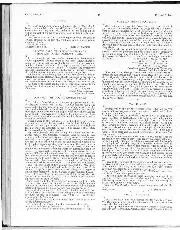
Towards the totalitarian state?
Sir My father, a 'bus driver, was stopped by a police motorcyclist for crossing a traffic light at red. He had noticed the police motorcyclist behind him for a quarter…
A year’s motoring in a fortnight UNDER R.A.C. OFFICIAL OBSERVATION
“no sludge or deposit”
little carbon deposit”
of 6118 miles per gallon”
all working parts in good condition”
“piston rings free in their grooves”
Yet PATENT Castro’ COSTS NO MORE
10,017 miles on the road by an Austin—without stopping the engine
EXTRACT FROM REPORT OF ROYAL AUTOMOBILE CLUB TRIAL No. 771. WAKEFIELD PATENT CASTROL “XL” OIL.
ENTRY.—Messrs. C. C. Wakefield & Company, Limited, of Wakefield House, 30/32 Cheapside, London, E.C.2, submitted for trial a sample of Wakefield Patent Castro] ” XL ” Engine Oil.
OBJECT OF TRIAL—The object of the trial, as declared by the entrants, was to demonstrate the performance of the oil in the engine of a car, running over a distance of 10,000 miles, without stopping the engine.
DESCRIPTION OF TRIAL—The car used for the trial was supplied by the entrants and was a 1935 18 h.p. Austin car, fitted with saloon body.
The trial run was. in three eight-hour shifts per 24 hours, intentional stops, with the engine running, being made for traffic, refreshments, and changing crew. The total distance covered was fo,017i miles at an average speed (settled by the entrants) of 32.2 miles per hour excluding all stops.
RECORD OF TRIAL.—The engine ran continuously throughout the trial for a total time of 341 hours 52 mins. The car was stationary, with the engine running, for a total time of 40 hours 12 mins., the longest stops being of 44 mins., 43 mins. and 43 mins. duration respectively.
The engine sump was drained and refilled before the start of the trial, but not again during the trial. The total amount of oil used was 1.64 gallons, equivalent to a consumption of 6,118 miles per gallon. Throughout the trial the oil level in the crankcase was maintained between the ” maximum ” oil level, as shown on the dipstick, and two-thirds full.
At the end of the trial the engine was completely dismantled. All working parts were found to be covered with a film of oil and were in good condition. The carbon deposit on the piston heads and cylinder heads was thin. There was little carbon deposit on the metal parts of the sparking plugs and the insulators were clean. The piston rings were free in their grooves.
The appearance of the parts was very consistent throughout. The wearing parts, being in uniformly good condition, were not photographed.
On dismantling, the engine sump was found to contain no sludge or deposit. THIS ADVERTISEMENT IS AUTHENTICATED BY THE ROYAL AUTOMOBILE CLUB